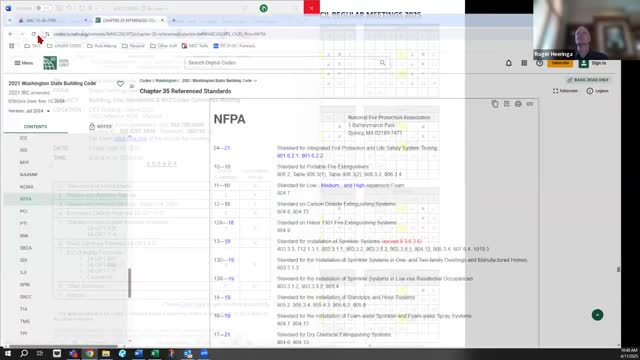Committee consolidates stair pressurization proposals, advances revised damper language; tables HVAC‑shutdown clarifications for further work
April 12, 2025 | Building Code Council, Governor's Office - Boards & Commissions, Executive, Washington
This article was created by AI summarizing key points discussed. AI makes mistakes, so for full details and context, please refer to the video of the full meeting. Please report any errors so we can fix them. Report an error »

The Building Fire, Residential and WUI (BFRW) committee on April 11 reviewed multiple petitions addressing stairway pressurization and related code cross‑references and moved to advance a consolidated and corrected revision while declining a duplicate, less‑complete petition.
During the meeting the committee discussed two stair pressurization petitions (GP1038 and GP1114) and a related request to align National Electrical Code (NEC) citations and NFPA references. Committee members and proponents agreed that one revision (GP1114, revision 3) contained more comprehensive editorial corrections and correct cross‑references; the committee voted to move the more complete revision forward to the State Building Code Council and to deny the overlapping petition (GP1038) as duplicative. The committee asked staff to include the corrected reference to NFPA 70 (the 2023 NEC reference) in the state reference listings (WAC chapter references) so that the cross‑code pointers are consistent.
Separately, the committee considered a proposed clarification about acceptable means to render HVAC ductwork “static” so that static fire dampers and static ceiling radiation dampers can be listed for use. Proponent Eric (last name not specified in the transcript) presented revised language that lists several acceptable actuation methods for shutting down HVAC that serves rated assemblies — options included connection to a fire alarm initiating device, duct heat detection devices, smoke detection integrated with alarm systems, and water‑flow alarm activation for sprinkler systems. Commenters from the fire and mechanical communities discussed practical details: (1) dynamic dampers are intended for systems that remain operational during a fire and are UL‑listed for dynamic operation, (2) many ceiling radiation dampers in the market are static types with fusible links typically rated ~165°F, and (3) small continuous ERV systems used in multifamily construction are common and present operational and enforcement questions because they run continuously.
Given outstanding technical clarifications, the committee tabled the damper shutdown clarifications until the next meeting and asked proponents and technical stakeholders (mechanical and fire protection engineers, manufacturers and AHJs) to work offline to refine the definitions and actuation temperature ranges, to confirm which devices qualify as listed heat or smoke detectors for duct use, and to provide suggested language consistent with NFPA 72/13 and the building code. The committee asked staff to circulate an introduction e‑mail to coordinate the follow‑up working group and directed proponents to meet before the next BFRW meeting.
Why it matters: Stair pressurization and acceptable methods to render ductwork static affect how projects satisfy egress and fire‑protection requirements. The committee’s decision to consolidate overlapping petitions and to refine acceptable shutdown mechanisms is intended to reduce inconsistent interpretations across jurisdictions.
What’s next: The committee forwarded the consolidated stair pressurization revision to the SBCC for CR102 consideration and set the damper/HVAC shutdown clarifications for further technical refinement with a targeted return at a future meeting.
During the meeting the committee discussed two stair pressurization petitions (GP1038 and GP1114) and a related request to align National Electrical Code (NEC) citations and NFPA references. Committee members and proponents agreed that one revision (GP1114, revision 3) contained more comprehensive editorial corrections and correct cross‑references; the committee voted to move the more complete revision forward to the State Building Code Council and to deny the overlapping petition (GP1038) as duplicative. The committee asked staff to include the corrected reference to NFPA 70 (the 2023 NEC reference) in the state reference listings (WAC chapter references) so that the cross‑code pointers are consistent.
Separately, the committee considered a proposed clarification about acceptable means to render HVAC ductwork “static” so that static fire dampers and static ceiling radiation dampers can be listed for use. Proponent Eric (last name not specified in the transcript) presented revised language that lists several acceptable actuation methods for shutting down HVAC that serves rated assemblies — options included connection to a fire alarm initiating device, duct heat detection devices, smoke detection integrated with alarm systems, and water‑flow alarm activation for sprinkler systems. Commenters from the fire and mechanical communities discussed practical details: (1) dynamic dampers are intended for systems that remain operational during a fire and are UL‑listed for dynamic operation, (2) many ceiling radiation dampers in the market are static types with fusible links typically rated ~165°F, and (3) small continuous ERV systems used in multifamily construction are common and present operational and enforcement questions because they run continuously.
Given outstanding technical clarifications, the committee tabled the damper shutdown clarifications until the next meeting and asked proponents and technical stakeholders (mechanical and fire protection engineers, manufacturers and AHJs) to work offline to refine the definitions and actuation temperature ranges, to confirm which devices qualify as listed heat or smoke detectors for duct use, and to provide suggested language consistent with NFPA 72/13 and the building code. The committee asked staff to circulate an introduction e‑mail to coordinate the follow‑up working group and directed proponents to meet before the next BFRW meeting.
Why it matters: Stair pressurization and acceptable methods to render ductwork static affect how projects satisfy egress and fire‑protection requirements. The committee’s decision to consolidate overlapping petitions and to refine acceptable shutdown mechanisms is intended to reduce inconsistent interpretations across jurisdictions.
What’s next: The committee forwarded the consolidated stair pressurization revision to the SBCC for CR102 consideration and set the damper/HVAC shutdown clarifications for further technical refinement with a targeted return at a future meeting.
View full meeting
This article is based on a recent meeting—watch the full video and explore the complete transcript for deeper insights into the discussion.
View full meeting
